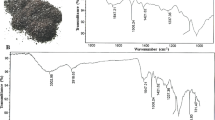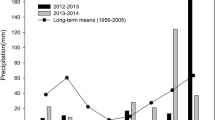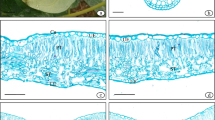Abstract
THE ear of cereals such as barley and wheat is an important photosynthetic organ in providing carbohydrate substrate for grain filling. This has been established by several workers, most recently by Archbold1 for barley and Asana and Mani2 for wheat. Their technique, as of previous workers, involved opaque shading of the ear to prevent photosynthesis, the resulting reduction in grain weight being taken to represent the normal ear contribution. Reductions of the order of 30 per cent have been obtained (Archbold measured whole ear weight only).
This is a preview of subscription content, access via your institution
Access options
Subscribe to this journal
Receive 51 print issues and online access
$199.00 per year
only $3.90 per issue
Buy this article
- Purchase on Springer Link
- Instant access to full article PDF
Prices may be subject to local taxes which are calculated during checkout
Similar content being viewed by others
References
Archbold, H. K., Ann. Bot., N.S., 6, 487 (1942).
Asana, R. D., and Mani, V. S., Physiol. Plant., 8, 8 (1955).
Buttrose, M. S., and May, L. H., Aust. J. Biol. Sci., 12, 40 (1959).
Archbold, H. K., Nature, 156, 70 (1945).
Porter, H. K., Pal, N., and Martin, R. V., Ann. Bot., N.S., 14, 55 (1950).
Author information
Authors and Affiliations
Rights and permissions
About this article
Cite this article
FREY-WYSSLING, A., BUTTROSE, M. Photosynthesis in the Ear of Barley. Nature 184, 2031–2032 (1959). https://doi.org/10.1038/1842031a0
Issue Date:
DOI: https://doi.org/10.1038/1842031a0
This article is cited by
-
An in situ approach to characterizing photosynthetic gas exchange of rice panicle
Plant Methods (2020)
-
In vitro enzyme activities and products of 14CO2 assimilation in flag leaf and ear parts of wheat (Triticum aestivum L.)
Photosynthesis Research (1986)
-
The effect of rain on β-glucan content in barley grains
Carlsberg Research Communications (1979)
-
Physiology of Grain Filling in Barley
Nature (1974)
-
Some enzyme activities associated with the chlorophyll containing layers of the immature barley pericarp
Planta (1973)
Comments
By submitting a comment you agree to abide by our Terms and Community Guidelines. If you find something abusive or that does not comply with our terms or guidelines please flag it as inappropriate.



